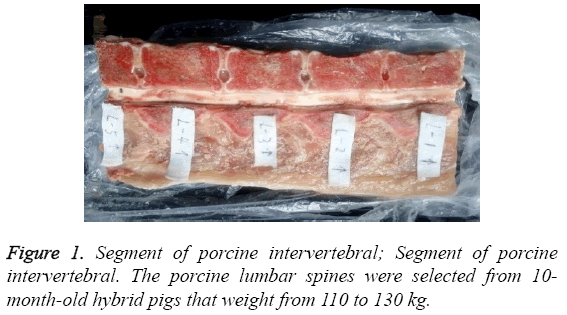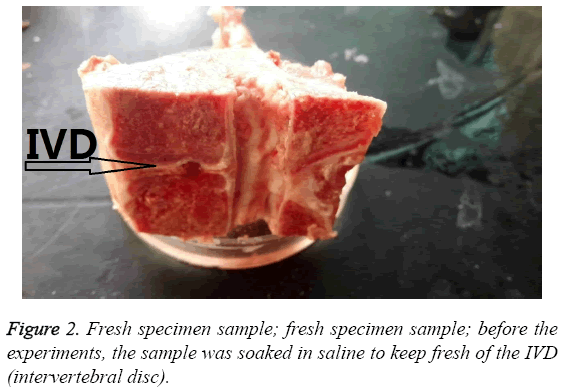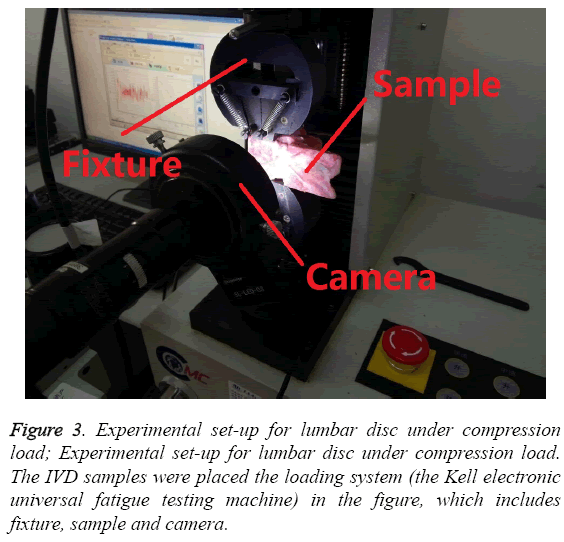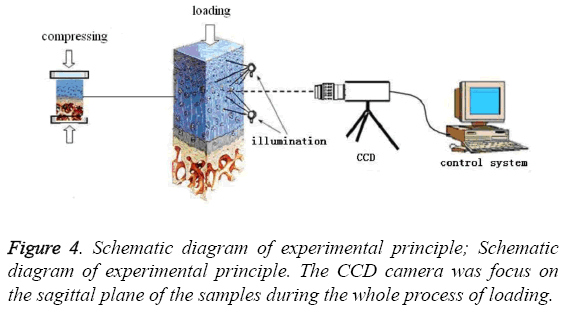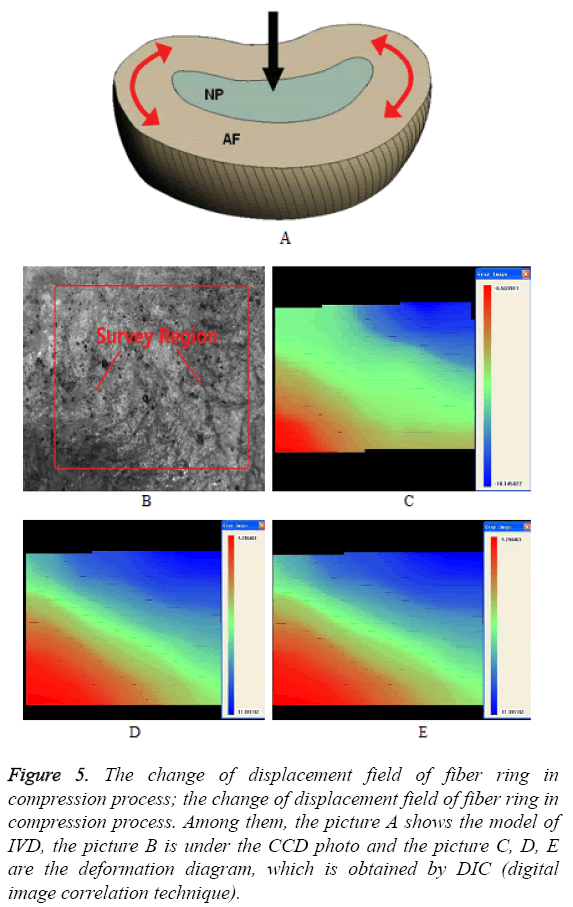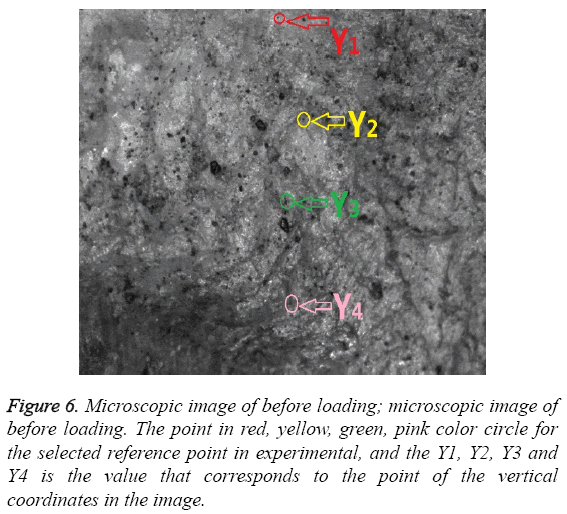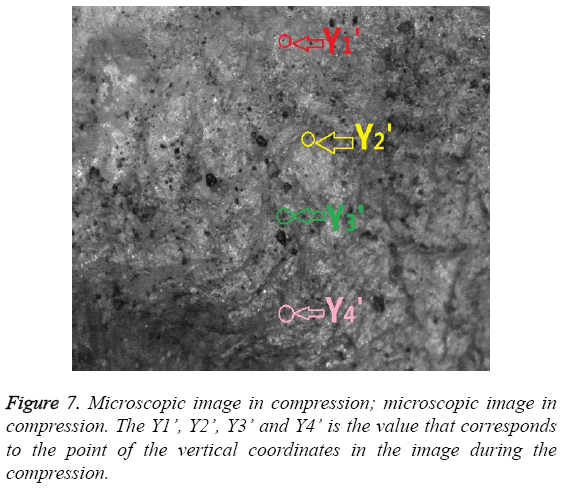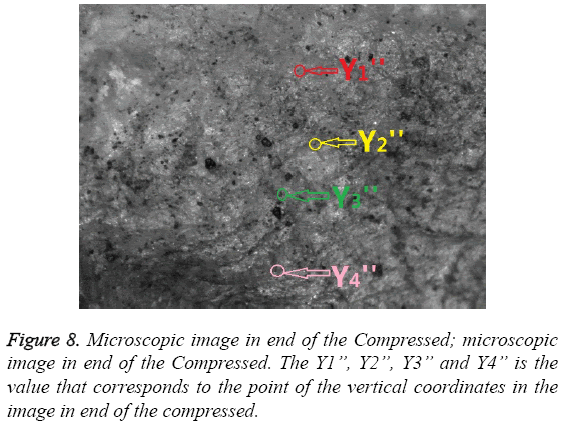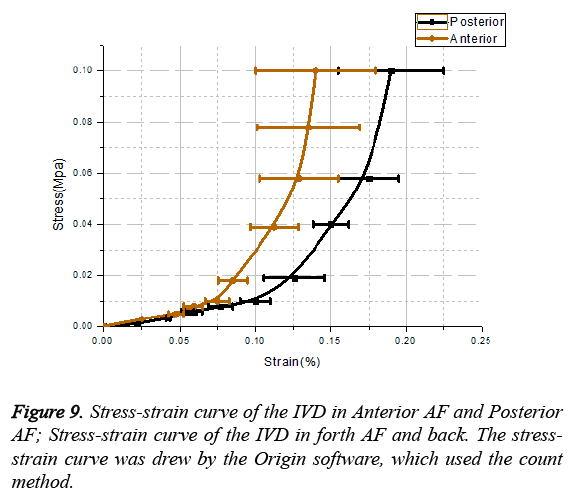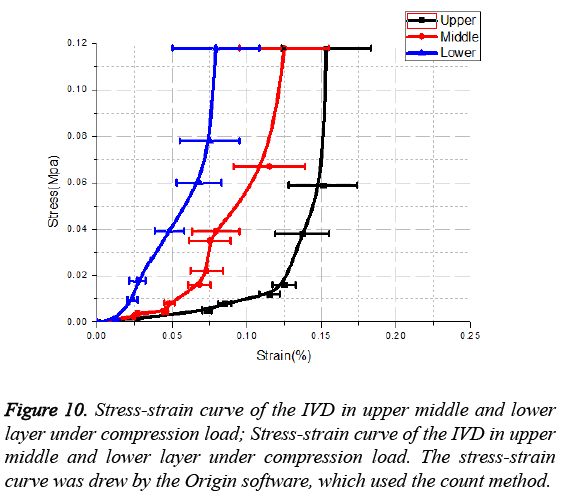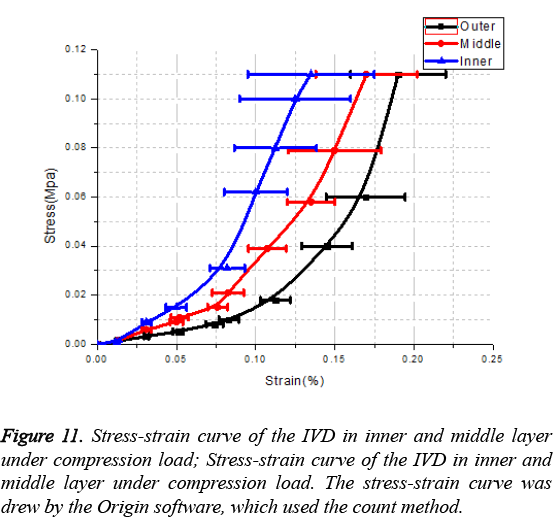Research Article - Biomedical Research (2017) Volume 28, Issue 2
The rule of strain in different stratification of the intervertebral disc under physiologic loading
Tao Yang1, Chun-qiu Zhang1*, Qing Liu1, Kun Li2, Xiu-ping Yang1, Jing-jing Zhang1, Yahui Hu1, Jindio Ye11Tianjin Key Laboratory for Control Theory and Applications in Complicated Industry Systems, School of Mechanical Engineering, Tianjin University of Technology, Tianjin 300384, PR China
2School of Electronic Information Engineering, Tianjin University of Technology, Tianjin, PR China
- *Corresponding Author:
- Chun-qiu Zhang
School of Mechanical Engineering
Tianjin University of Technology
Tianjin, PR China
Accepted date: July 27, 2016
Abstract
There is a common disease about Lumbar disc herniation in clinical medicine, which causes heavily burden in life and economic of patient. The spine mainly protects and supports the human body. Its primary functions include: 1) supporting the body in various positions, and transferring the load of head and torso to the pelvis; 2) making the trunk move in a wide range; 3) protecting the spinal cord, thoracic, abdominal and pelvic organs. Meanwhile, it is also very easy to hurt while is completing the above functions. There are complex etiological factors of lumbar disc herniation, but it is found that the biomechanical factors are the important reason to cause the disease. Therefore, the experiment was carried out with the lumbar intervertebral disc of pigs, using the digital image correlation technology and other special experimental instruments to further research the stress-strain state of the lumbar intervertebral disc under the different physiological loads, and to prevent the treatment systematical of intervertebral disc herniation. Integrating the analysis results of quantitative and qualitative, firstly, the stratification of annulus fibrosus can be found. Secondly, we can obtain that the outer strain is smaller than the inner strain, and the upper layer strain is larger than the lower strain. Thirdly, we can also found that intervertebral disc in the compression process; annulus fibrosus of stress-strain curve is nonlinear. The experimental knowledge may provide guide for the prevention and treatment of lumbar intervertebral disc disease, repair of lumbar intervertebral disc defect and there is a positive influence on the artificial lumbar intervertebral disc tissue engineering research and development. Moreover, the research can establish experimental data for a more mature finite element model to simulate annulus fibrosus function.
Keywords
Intervertebral disc, Annulus fibrosus, Optimized digital image correlation technique, Stratification, Stressstrain curve.
Abbreviations
IVD: Intervertebral Disc; NP: Nucleus Pulposus; AF: Annulus Fibrosus; DIC: Digital Image Correlation
Introduction
As is known to all, the spine mainly protects and supports the human body. The spine is moving in a wide range and bearing strength to be serious, which results in being subject to damage. Therefore for a long time, Chinese and foreign researchers have made a lot of researches on the physiology and pathology of human spine, in order to seek the effective way to protect and treat it. And a variety of traffic accidents, labor accidents often cause spinal injury, which further promotes the research of the spine’s mechanical properties. Intervertebral disc (IVD) disorders (desiccation, degeneration, herniation, etc.) have been directly associated with back pain and disability [1]. Current treatment options for IVD disorders do not restore normal tissue integrity or function. The direct medical and indirect costs of these conditions are unknown, but have been estimated in the range of $50 to $80 billion per annum, placing an economic burden on society [2-4]. IVD degeneration is a very common health problem around the world. It will lead to serious social and economic problems. According to incomplete statistics, about 80% of the middleaged are suffering from this disease, which makes lumbar pain and the lower part of the body limp and numb [5]. The study has found that there is a deep relationship between severe low back pain and degeneration of the IVD [6,7].
Many experiments on the mechanical properties of the IVD have been carried out [8]. Previous studies have shown that many factors have played an important role in such aspects, including life span and degradation [9,10], posture [11,12], muscle elasticity [13], carrying capacity [14], etc. The etiology of lumbar disc herniation is very complicated, but the scientific research shows that biomechanics is always an important factor. The biomechanical changes of the lumbar spine and its surrounding tissues lead to the issues of the pathological, biochemical, anatomical, etc. Furthermore, these issues interacting as both cause and effect aggravate lumbago disease [15]. IVD is important structure to maintain the spinal load and motor function, and there is a close relationship between the degenerative disc disease and the occurrence of protrusion of IVD with its mechanics state. IVD main compression bending tensile shear torsion and other physiological load in the human body activities, and the long-term mechanical load is considered to be the important causes of IVD degeneration. So it is necessary to deeply research the mechanical behavior of IVD, which will provide a good guidance for the prevention of IVD disease.
In the last 10 years, some scientists have done a lot of research on the mechanical properties of IVD by adopting different experimental methods and obtained the certain research results. In 2006, Wade had disc surgery on sheep and removed the nucleus pulposus (NP), focusing on the mechanical properties of annulus fibrosus (AF). He observed the mechanical properties of AF after the axial loading so that to study the strain of AF internal mechanics [16]. In 2008, Heuer et al. measures the IVD stress distribution with porcine lumbar bone, and found the relationship between the stress size and the position of reference point. They adopted laser scanners and other laboratory equipment to analysis mechanical properties of IVD analysis under different mechanical environment [17]. In 2010, Spera et al. who used whole deformation instrument on the basis of a three-dimensional digital image correlation (DIC) applications to measure the deformation of the whole pig disc by the use of axial loading. Through mechanical analysis software, disc displacement field, strain field can be obtained [18]. In 2014, Liu et al. made biomechanics performance research on the of pig AF [19], obtaining the stress and strain rules of the AF of the inner and outer layer and the upper and the lower layer by using DIC technique. In 2015, Barthelemy et al. conducted the tension and compression test of IVD by using mechanical tensile test machine, combined with the finite element model of the IVD, through simulation and experimental comparison, to achieve the AF mechanical properties [20]. Chad et al. used the IVD of sheep and adopted the cyclic loading method to study the influence of the AF defects on the mechanical properties [21]. Mizrahi et al. [22] used the finite element analysis software ANSYS to simulate the human lumbar IVD. Sun and Li [23] used 3D geometric model simulation of lumbar IVD space, and described the distribution of stress and strain and degenerative spine.
Because the IVD is a unique soft tissue [24], AF is easy to break under the condition of overloading and NP outflow oppresses nerve, causing pain to the patients. IVD contains high moisture, the AF contains about 70%, and 85% of the NP [25]. Specifically, the AF is surrounded by a circle around together, and each layer is a composite made of fibers and matrix, and the inner fiber is soft and outer fiber is hard. In summary, there is less layers research on the AF. At the same time, not too much of the mechanical properties of the AF is described. The innovation of this paper is focused on the mechanical strain relationship between AF and the layer, focusing on the stress and strain rule of different layers. The herniation of DIV is caused by AF disruption that results in the outflow of NP. The motivation of this experiment is to research the mechanical properties of each layer of the AF, which purse to provide the guidance for the repair of AF, furthermore, to contribute to the treatment of the disease of IVD.
Animal spines are popular to use in the biomechanical to analysis the prospective spinal instruments, for it easier available and cheaper than human tissues. For practical purpose, the animal spines are most greatly selected as the model for both in vitro and in vivo researches. The physiological structure of the pig and human is similar in anatomy and geometry, so this experiment selected the lumbar spine as the research object. The main method is to take the fresh pig lumbar IVD L1-2 segments, with the help of electronic universal testing machine and use of DIC technology for analysis and research. To observe the mechanical properties of the AF by compressing the L1-2 segments, the key point is to analyze the strain rule of the inner, middle and outer layers (horizontal direction) and the upper, middle and lower layers, and discuss the relationship between its sizes. In addition, to ensure the accuracy of the research, a number of experiments were carried out, through the change of the displacement of the selected nano reference point, a comprehensive analysis, and combined with the relevant data, draw the conclusion of the experiment.
Materials and Methods
Materials
In this study, 10 fresh porcine lumbar spines were selected from 10-month-old hybrid pigs that weight from 110 to 130 kg, as show in the Figure 1. The L1–L2 motion segments were separated and cut along the sagittal plane, because its internal structure can be clearly seen along the sagittal plane in medical analysis, and its fault can be observed and its internal components was destructed in the lowest degree. Traditional mechanical testing methods use the entire vertebral body as a sample, which cannot fully observe its internal structure and no specific. The spines, which attached muscles and ligaments and were storage under frozen conditions until testing, Before testing, thawing each specimen to room temperature and then wrapping it in cloth by normal saline soaked for 1-2.5 h. A total of 20 IVD samples with vertebra selected from 10 discs were made in size of about 35 mm in diameter and 4 mm in height, and then separated it into two groups. Treatment of materials of each group with a surgical knife, excluding all muscles and ligaments to retain the integrity of the IVD in order to achieve the experimental standard sample. Before the experiments, in order to keep all samples of the IVD fresh were soaked in saline, as show in the Figure 2. Earlier research has proved that the porcine cervical and human lumbar spines are similarities in anatomical, geometric, and functional [26,27].
Experimental apparatus
The Kell electronic universal fatigue testing machine and the acquisition of the image of the charge-coupled device (CCD) camera system (Center of Mechanical Shanghai University, China) DIC software was used to in this experiment. The Kell electronic universal testing machine system has specially compression experiment software, which can control the accuracy by adjustment of software parameters, and it also can automatically save experimental data. The experiment apparatus mainly compose of the following parts:
1. Image processing control software
2. Mechanical loading system
3. Image acquisition system
4. Computer control system
A progressive scan CCD camera was used to continuously acquire the 1376 × 1035 pixel, the magnification is 300 times, and then, the sequential image were analyzed by the image processing software to make the displacement fields and the strain fields. The main advantages of this experimental device include: 1) The camera and the loading device can be carried out simultaneously, and record the small changes in the IVD during the compression process in the whole process; 2) The accuracy and the magnification of the camera can satisfy the requirements of the experiment; 3) The parameters on the experimental conditions can be set and image processing can be carried out by the computer control system. The IVD samples were placed in the loading system, as show in the Figure 3.
Methods
So far, although the medical profession has not yet made a convincing explanation for the etiology of disc herniation, there is sufficient evidence to show that the degeneration of the IVD in the biochemical aspects and the influence of overload are the factors that cannot be ignored. Because the IVD is mainly subjected to axial compression. The IVD is mainly subjected to axial compression, therefor; the compression test has become the most commonly used method for testing mechanical properties.
DIC, also known as computer image processing, and its can combine with electro-optical technology, image processing, recognition technology, and computer technology to be used measuring of the whole shapethe deformation and movement. It is converted an image signal into a digital signal in the process and process it by the computer. In recent years, DIC has been widely used in the measurement of stress and strain in biomechanical testing, with great effectiveness. In this experiment, the Iron oxide nanoparticles was evenly coated on the surface of the IVD and it purpose to reflect the deformation of different regions of the IVD. The core technology of this experiment is to carry on the qualitative analysis of two aspects of work at the same time: First, recorded the displacement of the reference point attached to the AF by the camera system; Second, the continuous photos of collection were processed by the DIC to get the displacement field change.
In addition, to ensure the accuracy of the experimental results, the traditional "tracing point method" is used to make a quantitative analysis of the microscopic image of the AF. Specifically refers to that randomly selected four naked eye can identify the tiny reference points (The smaller the reference point, the better the effect and similar to a horizontal line) from the collection of the first micro image in accordance with the left to right and the selected points was divided into three layers. Then, put all the photos in the Photoshop software, because of the special features of the Photoshop software can show the current reference point in the coordinates of a picture. The displacement of the reference point is constantly changing in the compression process, which combined the mechanical formula and the change of the displacement can be calculated the stress strain and elastic modulus. Also, there is also selected four points from top to bottom and divided into the upper, middle and lower three layers. The specific method is same as above.
Experimental description
The test temperature was room temperature, and measured the front and back side of the IVD. Considering the random error, the ten samples of the first and second groups were continuously tested. We evenly paintcoated nano particles in the posterior and anterior and it played a role in the tracer, which purpose was to observe the AF and NP of deformation degree in the compression process. Setting the force, which acted on the IVD in the Kell testing machine software system, and the speed of the force is 0.02 mm/s, keeping the time of the force and other security parameters of the testing machine system. Setting the time interval of the image acquisition and a number of the picture and the preservation of the position in the image acquisition system, and it should be to ensure that the whole experiment process can take pictures until the end of the experiment. In this experiment, every second take a picture, and a total of 150 pictures, the force of the acceleration was 0.01 KN/s; to ensure the accuracy of the study, firstly pre pressed it once. After the end of the experiment, in order to restore the performance, the samples were immersed in physiological saline for 30 min, and then repeated the experiments after the sample was recovered.
The sagittal plane of the samples was focused by the CCD camera during the whole loading process; meanwhile, the analyzing the continuous images captured by the camera, which would obtain the displacement field and strain field. And to measure the load used the force sensor and real time displayed in the microcomputer. It shows the schematic diagram of the experimental principle in Figure 4.
Statistical analysis
A one-way analysis of variance (ANOVA) was carried on to decide the statistical difference in the strain values. In the statistical analysis, the P value is the probability, which reflects the probability of occurrence of an event. According to the P value obtained by the method of significance test, a p-value of smaller than 0.05 was indicated statistically significant. By using P<0.05, this experiment calculated the numerical changes of reference point displacement in compression and tension tests to calculate the statistic difference about strain values of every layer in AF and the between- groups test was analyzed by the single factor method.
Results
The change rule of the displacement field of the AF under compressive stress
The AF displacement field cloud picture was obtained by exerting a increasing continuous load on the IVD, at the same time, analyzing the picture that was obtained by the DIC technology and the camera system. Since accuracy of DIC measurements may be affected by errors related to the experimental setup (e.g. relative alignment of optics, quality of the illumination, features of the specimen surface, grey-level distribution and contrast of the imaged pattern, etc.) as well as by numerical errors introduced by image digitalisation processes, further calibration should be carried out before any measurements in order to check if strain values are correctly determined [28]. AF displacement field in the compression condition is analyzed by the DIC processing software, as shown in Figure 5 (Among them, the picture A shows the model of IVD, the picture B is under the CCD photo.) We can see that the color of the upper layer is the most shallow, the color gradually strengthened along the inclined direction down. The gray value on the right side of the figure represents the value of the numerical, and we can see that the deeper the color, the bigger the value. According to the rule of the image color changing can be seen that the rule of stratification is obvious and the outer layer of the strain is the smallest, the middle layer is the second, the inner layer is the biggest. Because the outer layer of the AF is harder than the inner layer, the inner layer of the variable is greater than the outer layer in the same compression force.
Figure 5: The change of displacement field of fiber ring in compression process; the change of displacement field of fiber ring in compression process. Among them, the picture A shows the model of IVD, the picture B is under the CCD photo and the picture C, D, E are the deformation diagram, which is obtained by DIC (digital image correlation technique).
The quantitative analysis of AF under compressive
The image process of the AF collected by the CCD camera system is shown in Figures 6-8 and the microstructure of the AF is shown in the image. The point in red, yellow, green, pink color circle for the selected reference point in experimental, and the Y1, Y2, Y3 and Y4 is the value that corresponds to the point of the vertical coordinates in the image. According to the above images can be obtained that the vertical strain, the stress and the elastic modulus respectively is
 →(1)
→(1)
 →(2)
→(2)
 →(3)
→(3)
Where F for the load, A for the area can be directly derived. Using the above formula, combined with the corresponding reference point of the coordinate changes, calculated out and the inner layer of the strain, and then made into a curve, the calculation of the elastic modulus of about 1.46 Mpa.
The AF under the process of compression, which can be divided into the upper, middle and lower the three layers and it also can be divided into inner, middle and outer three layers the horizontal direction. The IVD not only changes in the upper middle and lower levels, but also changes in the inner, middle and outer layers in the compression process.
The results of the posterior and anterior sides of the IVD were analyzed as shown in Figure 9, from the graph, it can be obtained that the stress of the anterior side is greater than that of the back side under the same strain. The strain on the back side is greater than the strain on the anterior side under the same strain and the magnitude of stress increases when the strain is 0.1%. It shows the stress strain curves of the upper, middle and lower three layers on the anterior side in Figure 10, which can be obtained that the strain of the upper layer is maximum and the stress of the lower layer is maximum, and the stress of the lower layer reaches the maximum at first, the strain amplitude of upper layer is maximum. It shows that the stress - strain curves of the inner middle and outer layers of the anterior side in Figure 11. Similarly, the strain of the outer layer is the smallest, and the inner strain is the largest, and the middle layer is in the middle, meanwhile, the speed of stress is also accelerated and there is a turning point when the strain is 0.1%. Because there is no obvious rule in the structure of the posterior side of the AF, this experiment only discusses the stratification of the anterior side.
Discussion
The purpose of this research was to study the internal strain in porcine lumbar motion segments under compressive and tensile load by playing an optimized DIC technique [29,30]. Meanwhile, we make the conclusion with the help of image analysis software and experimental data. If the spine is suffering from compressing, the NP forms will change, and different regions of AF bear pressure. According to our research results of strain distribution field in AF, we can predict the mechanical state when the each region of AF was repaired. In our daily life, the spinal cord is subjected to a variety of stresses that can lead to the breakdown of the AF and the tear of the connection between the AF and the vertebral end plate, which is considered to be one of the causes leading to overall disc degeneration or disc herniation. In this experiment, it be obtained the displacement field nephogram of AF and stress-strain curve, which comprehensive quantitative and qualitative analysis can be obtained: 1) The stratification of the AF, its vertical direction is divided into upper, middle and lower three layers, the horizontal direction is divided into the inner, middle and outer three layers; 2) The stratification AF is not vertical in the strict sense, but with certain tilt direction; 3) According to the color displacement field, the numerical value of the image can be clearly seen that the AF is the deepest color in upper layer, the next is middle layer, and the lower layer is the shallowest; 4) In the same conditions, strain on the posterior side is larger than the anterior strain, the stress of the anterior side is greater than that of the posterior side; 5) The quantitative and qualitative analysis can be used to obtain the maximum strain in the inner layer and the upper layer.
The conclusions of this study are consistent with the conclusions of previous researchers. For example, Heuer et al. [17] adopt three-dimensional laser scanner to axial compression the IVD, who obtained the outer layer of the AF strain is less than the inner strain. Recently, Ryan et al. [31] thought that the stress of the inner layer of the AF is slightly larger than the outer layer, the inner strain is greater than the outer layer. O 'Connell et al. [32] and other thought that the axial strain of the posterior side is greater than the strain of the anterior side, inner strain is slightly larger than the outer layer when the neutral region of AF and the AF is compressed. Liu et al. [19] studied the mechanical performance of AF and also adopts the manner of loading and compression, who thought that the inner strain is larger than the outer strain, in the same strain under the condition of outer stress greater than the inner stress under the same pressure. However, there are inconsistence Wade et al. [33] through the experiment get the outer layer of the AF displacement fields is larger than the inner layer of the displacement field, which is not consistent with the displacement field distribution. Brown [34] and Galante [35] profound research the tensile strength of the AF, the Brown studied the tensile strength of the AF along the axial direction. The Galante determined the stiffness and strength of the tensile strength of the AF under non axial compression. The results show nonlinear relationship between load and deformation of IVD, which is consistent with the conclusion of the experiment.
In addition, the elastic modulus of the IVD in the compression state is about 1.46 Mpa. But these results are not consistent with other results [36], which is caused by the loading mode of the present experiment. The loading force size is 0-300 N in the experiment process, the external force and people are roughly under normal load conditions rather [37]. We cannot accurately calculate the deformation, so the result of strain calculation may be error.
Conclusion
The optimized DIC technique was used to research the strain distribution of the IVD under unlimited compression load. Above all, which obtain the following conclusions: 1) the experimental results show us that the posterior strain was bigger than the anterior strain; 2) The inner strain of the AF is maximum, and the outer strain is minimum; 3) The upper layer of the AF strain is the largest, and the lower layer is the least. And clearly, it can be obtained that the stress-strain curves show nonlinear.
Our results show these things and this are the following significance: First, the experimental knowledge may provide guide for the prevention and treatment of lumbar IVD disease, repair of lumbar IVD defect; Second, there is a positive influence on that the artificial lumbar IVD tissue engineering research and development; Third, in this study, we focus on the micro mechanical changes of the AF components, and further understand the biomechanical properties of the AF. Moreover, the research can establish experimental data for a more mature finite element model to simulate the AF function.
Acknowledgement
The authors are grateful for the support of the National Natural Science Foundation of China [grant numbers: 81272046, 11372221, and11432016], and Tianjin key Program 15JCZDJC32800.
References
- Samartzis D, Karppinen J, Mok F, Fong DY, Luk KD. A population-based study of juvenile disc degeneration and its association with overweight and obesity, low back pain, and diminished functional status. J Bone Joint Surg Am 2011; 93: 662-670.
- Frymoyer JW, Cats-Baril WL. An overview of the incidences and costs of low back pain. OrthopClin North Am 1991; 22: 263-271.
- Maniadakis N, Gray A. The economic burden of back pain in the UK. Pain 2000; 84: 95-103.
- Urban JP, Roberts S. Degeneration of the intervertebral disc. Arthritis Res Ther 2003; 5: 120-130.
- Waddell G. Low back pain: a twentieth century health care enigma. Spine (Phila Pa 1976) 1996; 21: 2820-2825.
- Videman T, Battié MC, Gibbons LE, Maravilla K, Manninen H. Associations between back pain history and lumbar MRI findings. Spine (Phila Pa 1976) 2003; 28: 582-588.
- Videman T, Nurminen M. The occurrence of anular tears and their relation to lifetime back pain history: a cadaveric study using barium sulfate discography. Spine (Phila Pa 1976) 2004; 29: 2668-2676.
- Chu JY, Skrzypiec D, Pollintine P. Can compressive stress be measured experimentally within the annulus fibrosus of degenerated intervertebral discs? ProcIMechE, Part H: J Eng Med 2008; 222: 161-170.
- Adams MA, McMillan DW, Green TP, Dolan P. Sustained loading generates stress concentrations in lumbar intervertebral discs. Spine (Phila Pa 1976) 1996; 21: 434-438.
- McNally DS, Adams MA, Goodship AE. Can intervertebral disc prolapse be predicted by disc mechanics? Spine (Phila Pa 1976) 1993; 18: 1525-1530.
- Adams MA, Freeman BJ, Morrison HP, Nelson IW, Dolan P. Mechanical initiation of intervertebral disc degeneration. Spine (Phila Pa 1976) 2000; 25: 1625-1636.
- Edwards WT, Ordway NR, Zheng Y, McCullen G, Han Z. Peak stresses observed in the posterior lateral anulus. Spine (Phila Pa 1976) 2001; 26: 1753-1759.
- Wilke HJ, Krischak S, Claes L. Biomechanical comparison of calf and human spines. J Orthop Res 1996; 14: 500-503.
- McNally DS, Adams MA. Internal intervertebral disc mechanics as revealed by stress profilometry. Spine (Phila Pa 1976) 1992; 17: 66-73.
- Schmidt H, Haeussler K, Wilke HJ. Structural behavior of human lumbar intervertebral disc under direct shear[J]. J ApplBiomater Function Materia 2015, 13: 66-71.
- Johannessen W, Cloyd JM, O'Connell GD, Vresilovic EJ, Elliott DM. Trans-endplate nucleotomy increases deformation and creep response in axial loading.Annal Biomed Eng 2006; 34: 687-696.
- Heuer F, Schmidt H, Wilke HJ. The relation between intervertebral disc bulging and annular fiber associated strains for simple and complex loading. J Biomech 2008; 41: 1086-1094.
- Spera D, Genovese K, Voloshin A. Application of Stereo-Digital Image Correlation to Full-Field 3-D Deformation Measurement of Intervertebral Disc. Int J ExpMech 2010.
- Liu Q, Wang TY, Yang XP, Li K, Gao LL, Zhang CQ, Guo YH. Strain distribution in the intervertebral disc under unconfined compression and tension load by the optimized digital image correlation technique. ProcInstMechEng H 2014; 228: 486-493.
- Barthelemy VMP,vanRijsbergen MM,Wilso W,Huyghe JM, van-Rietbergen B, Ito K. A computational spinal motion segment model incorporating a matrix composition-based model of the intervertebral disc. JMechBehavior Biomed Mater 2016; 54: 194-204.
- Gooyers CE, Callaghan JP. Exploring interactions between force, repetition and posture on intervertebral disc height loss and bulging in isolated porcine cervical functional spinal units from sub-acute-failure magnitudes of cyclic compressive loading. J Biomech 2015; 48: 3701-3708.
- Mizrahi J, Silva MJ, Hayes WC. Finite element stress analysis of simulated metastatic lesions in the lumbar vertebral body. J Biomed Eng 1992; 14: 467-475.
- Sun W, Li H. An approach to assessment of strain and stress distribution of intervertebral disc using CT images. In: Proceedings of IEEE/ICME international conference on complex medical engineering, Beijing, China,766-769. New York: IEEE.
- Yingling VR, Callaghan JP. The porcine cervical spine as a model of the human lumbar spine: an anatomical, geometric, and functional comparison. J Spinal Disord 1999; 12: 415-423.
- Oxland TR, Panjabi MM, Southern EP, Duranceau JS. An anatomic basis for spinal instability: a porcine trauma model. J Orthop Res 1991; 9: 452-462.
- Adam C.Inter-lamellar shear resistance confers compressive stiffness in the intervertebral disc: An image-based modelling study on the bovine caudal disc.J Biomech 2015; 48: 4303-4308.
- Accadbled F, Laffosse JM, Ambard D, Gomez-Brouchet A, de-Gauzy JS, SwiderP. Influence of location, fluid flow direction, and tissue maturity on the macroscopic permeability of vertebral end plates. Spine 2008; 33: 612-619.
- Smith BW, Li X, Tong W. Error assessment for strain mapping by digital image correlation. Exp Tech 1998; 22: 19-21.
- Gao LL, Zhang CQ, Dong LM. Description of depth-dependent nonlinear viscoelastic behavior for articular cartilage in unconfined compression. Mat Sci-Eng C 2012; 32: 119-125.
- Zhang CQ, Gao LL, Dong LM Depth-dependent axial strain of articular cartilage under sliding load by the optimized digital image correlation technique. Mat SciEng C 2012; 32: 2390-2395.
- Ryan G, Pandit A, Apatsidis D. Stress distribution in the intervertebral disc correlates with strength distribution in subdiscal trabecular bone in the porcine lumbar spine. ClinBiomech (Bristol, Avon) 2008; 23: 859-869.
- O'Connell GD, Vresilovic EJ, Elliott DM. Human intervertebral disc internal strain in compression: the effect of disc region, loading position, and degeneration. J Orthop Res 2011; 29: 547-555.
- Johannessen W. Human Internal Disc Strains in Axial Compression Measured Noninvasively Using Magnetic Resonance Imaging. Spine 1976; 32: 2860-2868.
- Brown T, Hansen RJ, Yorra AJ. Some mechanical tests on the lumbosacral spine with particular reference to the intervertebral discs; a preliminary report. J Bone Joint Surg Am 1957; 39-39A: 1135-1164.
- Galante JO. Tensile properties of the human lumbar annulus fibrosus. ActaOrthopScand 1967.
- Causa F, Manto L, Borzacchiello A, De Santis R, Netti PA. Spatial and structural dependence of mechanical properties of porcine intervertebral disc. J Mater Sci Mater Med 2002; 13: 1277-1280.
- Keller TS, Holm SH, Hansson TH, Spengler DM. 1990 Volvo Award in experimental studies. The dependence of intervertebral disc mechanical properties on physiologic conditions. Spine (Phila Pa 1976) 1990; 15: 751-761.
